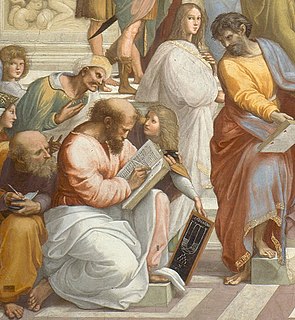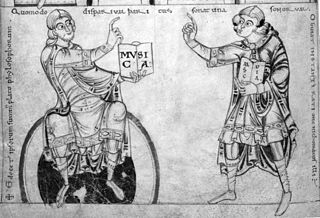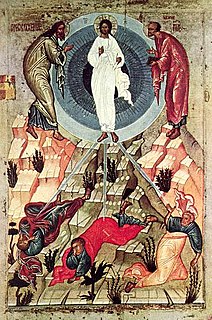In the Platonic, Neopythagorean, Middle Platonic, and Neoplatonic schools of philosophy, the demiurge is an artisan-like figure responsible for fashioning and maintaining the physical universe. The Gnostics adopted the term demiurge. Although a fashioner, the demiurge is not necessarily the same as the creator figure in the monotheistic sense, because the demiurge itself and the material from which the demiurge fashions the universe are both considered to be consequences of something else. Depending on the system, they may be considered to be either uncreated and eternal or the product of some other entity.

Numerology is any belief in the divine or mystical relationship between a number and one or more coinciding events. It is also the study of the numerical value of the letters in words, names, and ideas. It is often associated with the paranormal, alongside astrology and similar divinatory arts.

Pythagoras of Samos was an ancient Ionian Greek philosopher and the eponymous founder of Pythagoreanism. His political and religious teachings were well known in Magna Graecia and influenced the philosophies of Plato, Aristotle, and, through them, Western philosophy. Knowledge of his life is clouded by legend, but he appears to have been the son of Mnesarchus, a gem-engraver on the island of Samos. Modern scholars disagree regarding Pythagoras's education and influences, but they do agree that, around 530 BC, he travelled to Croton in southern Italy, where he founded a school in which initiates were sworn to secrecy and lived a communal, ascetic lifestyle. This lifestyle entailed a number of dietary prohibitions, traditionally said to have included vegetarianism, although modern scholars doubt that he ever advocated for complete vegetarianism.
Pythagorean, meaning of or pertaining to the ancient Ionian mathematician, philosopher, and music theorist Pythagoras, may refer to:

Pythagoreanism originated in the 6th century BC, based on the teachings and beliefs held by Pythagoras and his followers, the Pythagoreans. Pythagoras established the first Pythagorean community in Crotone, Italy. Early Pythagorean communities spread throughout Magna Graecia.

Nicomachus of Gerasa was an important ancient mathematician best known for his works Introduction to Arithmetic and Manual of Harmonics in Greek. He was born in Gerasa, in the Roman province of Syria. He was a Neopythagorean, who wrote about the mystical properties of numbers.

Iamblichus was a Syrian Neoplatonist philosopher of Arab origin. He determined the direction that would later be taken by Neoplatonic philosophy. He was also the biographer of the Greek mystic, philosopher and mathematician Pythagoras.

Hippasus of Metapontum was a Pythagorean philosopher. Little is known about his life or his beliefs, but he is sometimes credited with the discovery of the existence of irrational numbers. The discovery of irrational numbers is said to have been shocking to the Pythagoreans, and Hippasus is supposed to have drowned at sea, apparently as a punishment from the gods for divulging this. However, the few ancient sources which describe this story either do not mention Hippasus by name or alternatively tell that Hippasus drowned because he revealed how to construct a dodecahedron inside a sphere. The discovery of irrationality is not specifically ascribed to Hippasus by any ancient writer.
Theano of Crotone is the name given to perhaps two Pythagorean philosophers. She has been called the pupil, daughter or wife of Pythagoras, although others made her the wife of Brontinus. Her place of birth and the identity of her father are just as uncertain, there is some uncertainty if Theano can be the daughter of Brontinus the Orphic, it is still misleading but many sources are explaining that Brontinus might be the best chance to be the father of Theano, even though other made her the wife of Brontinus, leading some authors to suggest that there was more than one person whose details have become merged. A few fragments and letters ascribed to her have survived which are of uncertain authorship.
The Monad in early Christian gnosticism is an adaptation of concepts of the Monad in Greek philosophy to Christian gnostic belief systems.

Neopythagoreanism was a school of Hellenistic philosophy which revived Pythagorean doctrines. Neopythagoreanism was influenced by Middle Platonism and in turn influenced Neoplatonism. It originated in the 1st century BCE and flourished during the 1st and 2nd centuries CE. The 1911 Britannica describes Neopythagoreanism as "a link in the chain between the old and the new" within Hellenistic philosophy. Central to Neopythagorean thought was the concept of a soul and its inherent desire for a unio mystica with the divine.
Syrianus was a Greek Neoplatonist philosopher, and head of Plato's Academy in Athens, succeeding his teacher Plutarch of Athens in 431/432. He is important as the teacher of Proclus, and, like Plutarch and Proclus, as a commentator on Plato and Aristotle. His best-known extant work is a commentary on the Metaphysics of Aristotle. He is said to have written also on the De Caelo and the De Interpretatione of Aristotle and on Plato's Timaeus.

The tetractys, or tetrad, or the tetractys of the decad is a triangular figure consisting of ten points arranged in four rows: one, two, three, and four points in each row, which is the geometrical representation of the fourth triangular number. As a mystical symbol, it was very important to the secret worship of Pythagoreanism. There were four seasons, and the number was also associated with planetary motions and music.
Numenius of Apamea was a Greek philosopher, who lived in Apamea in Syria and Rome, and flourished during the latter half of the 2nd century AD. He was a Neopythagorean and forerunner of the Neoplatonists.
Damo was a Pythagorean philosopher said by many to have been the daughter of Pythagoras and Theano.

Monad refers, in cosmogony, to the Supreme Being, divinity or the totality of all things. The concept was reportedly conceived by the Pythagoreans and may refer variously to a single source acting alone, or to an indivisible origin, or to both. The concept was later adopted by other philosophers, such as Gottfried Wilhelm Leibniz, who referred to the monad as an elementary particle. It had a geometric counterpart, which was debated and discussed contemporaneously by the same groups of people.

Henosis is the classical Greek word for mystical "oneness", "union" or "unity". In Platonism, and especially Neoplatonism, the goal of henosis is union with what is fundamental in reality: the One, the Source, or Monad. The Neoplatonic concept has precedents in the Greek mystery religions as well as parallels in Eastern philosophy. It is further developed in the Corpus Hermeticum, in Christian theology, Alevism, soteriology and mysticism, and is an important factor in the historical development of monotheism during Late Antiquity.
Brontinus of Metapontum was a Pythagorean philosopher, and a friend and disciple of Pythagoras himself. Alcmaeon dedicated his works to Brontinus as well as to Leon and Bathyllus. Accounts vary as to whether he was the father or the husband of Theano.
Arignote or Arignota was a Pythagorean philosopher from Croton or Samos. She was known as a student of Pythagoras and Theano and, according to some traditions, their daughter as well.









